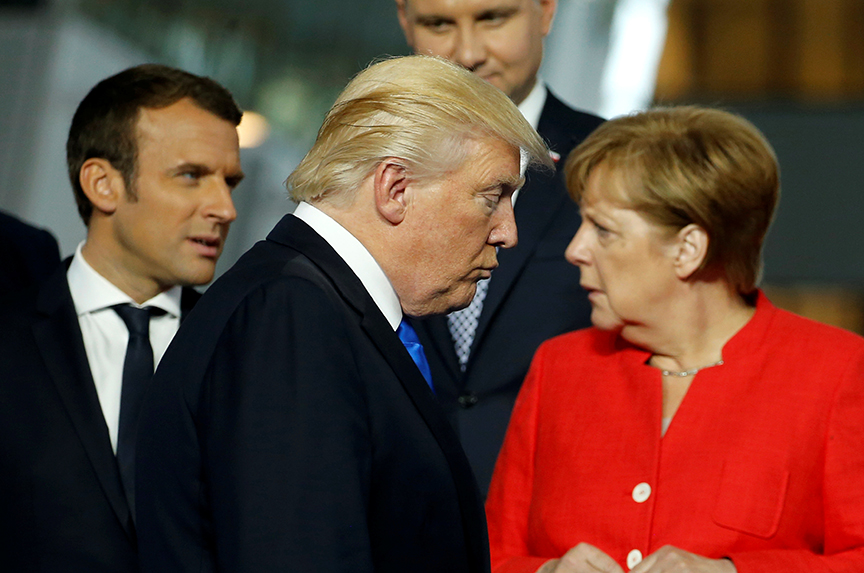
This article is part of a series reflecting on the first year of the Trump administration.
US President Donald J. Trump’s public skepticism toward multilateral organizations has created uncertainty among traditional US allies. Washington’s commitment to NATO, in particular, has been called into question in the first year of the administration. Despite critical rhetoric and ongoing concerns over allied burden-sharing, the Trump administration, alongside European allies, continues to take concrete steps to bolster transatlantic security.

What was existing US policy toward NATO?
The United States was heavily involved in the formation of NATO—a politico-military alliance formed to guarantee the freedom and security of its members—and, since, the Alliance has served as the cornerstone of the transatlantic partnership. A linchpin of the Alliance is the understanding that its members will come to one another’s defense, and that an attack against one is considered an attack against all. In action, Article 5, NATO’s collective defense clause, was invoked for the first and only time in support of the United States after the terror attacks on 9/11.
Since its creation in 1949, NATO has served as the main tool for US security engagement in Europe, and a framework for the United States to work with its transatlantic allies and partners to grapple with the most concerning mutual security challenges. In light of growing Chinese influence, the early administration of former US President Barack Obama shifted its foreign policy toward a “rebalance to Asia.” Consequently, Washington dialed back its engagement in Europe, pulling out US forces and equipment to focus greater attention on the Asia-Pacific region. However, following the Russian annexation of Crimea and intervention in Ukraine in 2014, the Obama administration refocused its attention on European security, and authorized the European Reassurance Initiative (ERI) which provides US funds for exercises, presence, and infrastructure upgrades geared toward better deterrence in Europe.
What has Trump said?
As a candidate, and in the early days of his administration, Trump questioned the value and purpose of NATO, calling the Alliance “obsolete” and as “costing us [the United States] a fortune.” During his first Leaders’ Meeting with NATO heads of state in Brussels in May 2017, President Trump criticized NATO allies for not spending enough on defense or reaching the agreed-upon goal that allies would spend 2 percent of their national gross domestic product (GDP) on defense. These statements created a great deal of uncertainty among allies who rely on the US commitment to their shared security. Despite these concerns, over time Trump has softened some of his rhetoric and explicitly backed Article 5.
How has the policy changed?
More than previous US presidents, Trump has reinvigorated the debate around burden sharing and commitments to defense spending within NATO. Despite alluding to a more transactional collective defense relationship, in practical terms the administration’s policy toward European security has been broadly constructive. US spending toward European security through the European Deterrence Initiative (EDI, previously ERI), has increased by $1.4 billion over the fiscal year 2017, bringing the fund to almost $5 billion per fiscal year. Further, US participation in military exercises across Europe has continued, including bringing high-end capabilities such as B-1s and B-52s to Europe for exercises and training. US Secretary of Defense James Mattis has made numerous visits to European countries, holding several bilateral meetings with his counterparts. Moreover, the recently-released US National Defense Strategy reaffirms the US commitment to NATO by explicitly focusing on “fortifying” the transatlantic alliance and referring to the US’ alliances and partnerships as “the backbone of global security”. While the tone and nature of the US relationship with its core European allies and partners has changed under the Trump administration, many of the actual US commitments to upholding European security have trended positive.
Clementine G. Starling is an assistant director in the Atlantic Council’s Transatlantic Security Initiative. You can follow her on Twitter @StarlingCG.
Image: US President Donald Trump (center) walked past French President Emmanuel Macron (left) and German Chancellor Angela Merkel on his way to his spot for a family photo during the NATO summit in Brussels, Belgium, on May 25. (Reuters/Jonathan Ernst)


